It’s been nearly a year since many found themselves suddenly working from home; swapping their desks for dining tables, the company of colleagues for pets, and grab-and-go lunches for last night’s leftovers.
So, what else has changed in that time? Now that WFH has become business as usual, how are we feeling?
Sodexo and Harris Interactive have been tracking employee sentiment on a range of topics during the course of the global pandemic, monitoring physical and mental well-being, productivity and the benefits and drawbacks of remote working. Based on this global, multi-phase survey with waves in April, June and October 2020:
- 56% of employees feel positive (enthusiastic or relieved) about returning to their pre-pandemic workplace
- 63% are concerned about their health and safety at the office now, or when they return to the office
- 85% want the option to continue working remotely and at a higher frequency
Based on the latest results, the WFH workforce is getting more comfortable working in their non-traditional workspaces and hoping to have the flexibility of remote work in the future. Challenges also exist as some employees still grapple with declining mental well-being, and the majority of workers are concerned about their health and safety when returning to the office. Lastly, expectations of the types of workplace services employees would like to be offered from their employers are evolving.
Despite Distance Working, Employee Engagement Rises
Even without consistent in-person interactions, people are forging healthy working relationships virtually. Compared to June, employee engagement increased globally (69% in October vs 67% in June) and 42% of North American employees said they felt a higher sense of belonging to their workplace community. In addition, North American employees felt more positive about their organisation’s communication and flexibility during the pandemic compared to the global average.
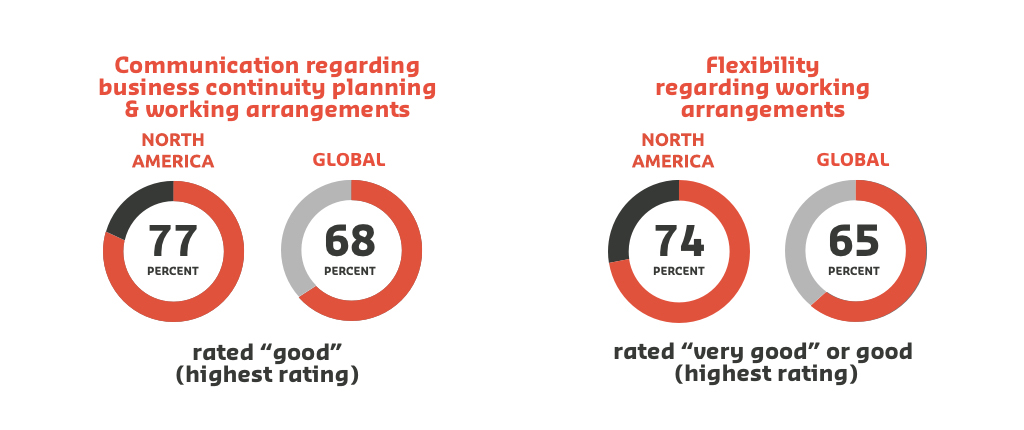
Graphic: Communication regarding business continuity planning and working arrangements. 77 percent in North America. 68 percent globally rated good as the highest rating. Flexibility regarding working arrangements. 74 percent in North America. 65 percent globally rated very good or good as the highest rating.
Why do employees seem to be more connected now even though the majority are still not working together in the same space? This may be a result of employers’ intentional planning of employee engagement initiatives. The importance of those initiatives in nurturing employee relationships has been the focus of much thought leadership content and media attention. Research also showed team building and maintaining a strong company culture are essential in order to keep people engaged and productive.
So, What Now? Leaders should continue investing in well-being support services for employees and the in-office perks that mean the most to employees.
Remote Working: More Productive and Comfortable
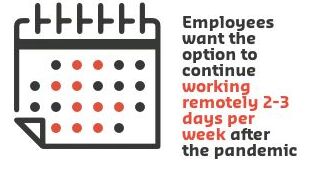
According to Research Co. 80% of Canadians who are currently working from home say they would like to be given the option to work from home more often when the pandemic ends, an increase of 15% since April 2020. The data shows many people enjoy working from home and that they have adjusted fairly well to the shift. Remote workers continue to see the benefits of working outside of their traditional, pre-pandemic workspaces.
What’s more, some WFH components that were cited as disadvantages in June are now either improving or being cited as non-issues.
Graphic: Employees want the option to continue working remotely 2 to 3 days per week after the pandemic.
Our research showed:
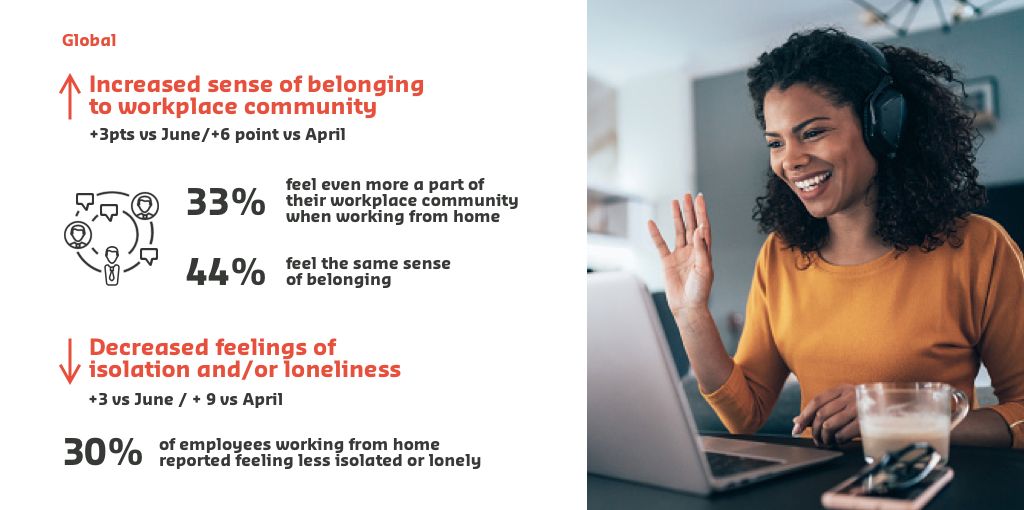
Graphic: Globally, there is an increased sense of belonging to workplace community. 33 percent feel even more a part of their workplace community when working from home. 44 percent feel the same sense of belonging. There is a decreased feeling of isolation and loneliness. 30 percent of employees working from home reported feeling less isolated or lonely.
Those who WFH report a better working environment and rate their ability to get the job done at home higher than at their normal place of work.
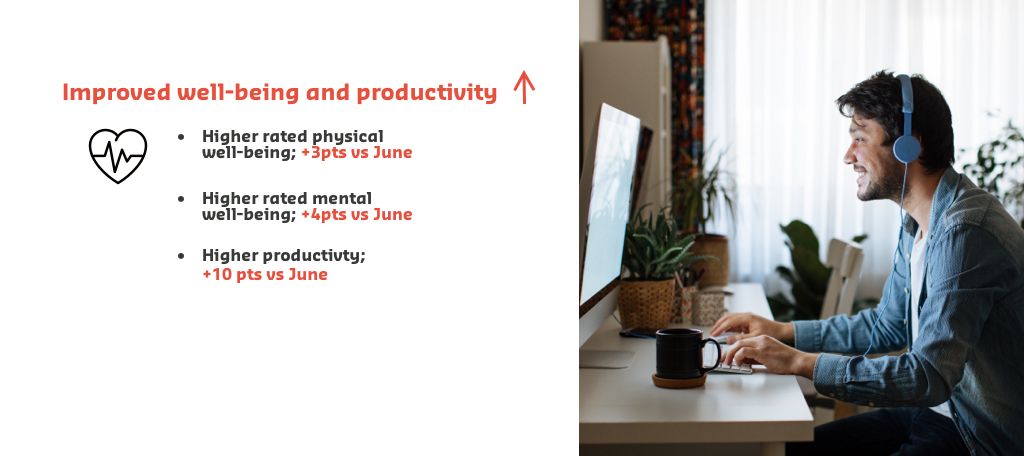
Graphic: There is improved well-being and productivity. There are higher levels of physical well-being, mental well-being, and higher productivity.
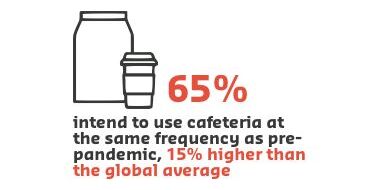 Role of Food in the Return to the Office (Whenever That May Be)
Role of Food in the Return to the Office (Whenever That May Be)
According to our research, 50% of workers globally will visit their cafeteria/canteen at the same rate as before the pandemic. Thirty percent of the workers who will visit the cafeteria less often plan to order food for delivery.
If they are eating in-office, what do employees want the most? What will keep them engaged, healthy and productive?
Graphic: 65 percent intend to use cafeteria at the same frequency as pre-pandemic, which is 15 percent higher than the global average.
In our research, we found:
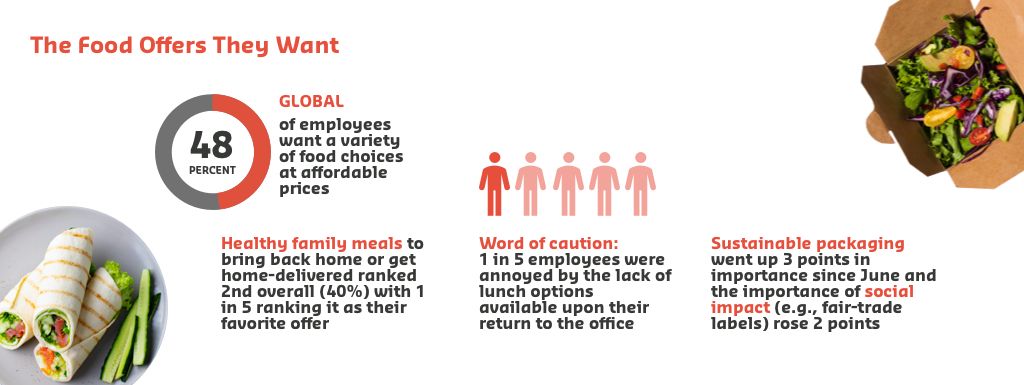
Graphic: The food offers they want. Globally, 48 percent of employees want a variety of food choices at affordable prices. Healthy family meals to bring back home or get home-delivered ranked second overall at 40 percent with 1 in 5 ranking it as their favorite offer. Word of caution. 1 in 5 employees were annoyed by the lack of lunch options available upon their return to the office. Sustainable packaging went up 3 points in importance since June and the importance of social impact, for instance, fair trade labels, rose 2 points.
As you know, a significant number of people returned to the office to work in the latter half of 2020. Of those who returned to office spaces, 65% of workers globally described the experience “as good as they expected” and 23% said it was “better than they expected.”
So, What Now? The return to the office is another opportunity to show employees that you care and that you’ve been hard at work ensuring their new workspace will fit their changing needs.
There is an important role for food to play in creating attractive, collaborative workplaces. It’s time to promote tasty, healthy and on-trend food services – everything from home and office meal delivery to click & collect and mobile ordering. As an added benefit, consider free on-site food and drinks (e.g., coffee or snacks) as this was cited as the 2nd most desired employee benefit.
Let’s Do This
As we all continue in our now not-so-new routines, we’re also eagerly waiting to see what’s on the horizon for the future of work. There’s plenty we can do now to continue supporting our teams and propel our businesses forward despite the uncertainty of what the headlines will say tomorrow.
Here’s a quick recap of action items to consider:
- Invest in well-being support services for employees
- Ensure worklife services are available and beneficial to employees regardless of where they work
- Offer attractive benefits, such as great food, free beverages and/or flexible workspaces
- Use food to help create more attractive, collaborative workplaces and make digital ordering and delivery available
- Prepare to implement remote work options post-pandemic
Sodexo’s Vital Spaces empowers organisations to transform their workplaces and plan for shifting futures. Read more about Vital Spaces and see how together, we can optimise experiences and spaces with services that enable productivity and connection wherever your teams do work.


